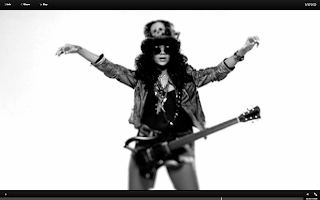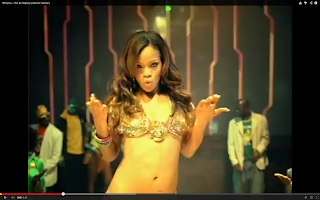Goodwin stated that a music video is a way for artists to showcase their new identity and development over time. This relates to an artists star image. This is constructed through close up shots of the artist themselves and through them lip syncing in the video. Vernallis commented that the lip syncing is crucial because the purpose of the video is to sell the song, and more importantly advertise the artist.
This screenshot is a clever way of emphasising the lip sync as what else would you show other than the artists lips whilst they are singing the song.
This example of a close up exemplifies Goodwin's theory that music videos act as a platform for artists to reinforce their new image.
This video immediately echoes Vernallis' theory of editing to the beat as is shown in the opening. Here is a clip of the opening of the video that I am referring to:
Moreover, Vernallis commented that the artist in a video is constantly on camera, whilst extras are placed into the background so the focus is on the star. This can bee seen through the way the staging is set up in the performance part of the video.
Another aspect of this screenshot to take note of is the fact that Rihanna is in considerably less clothing than the men in the band. This relates back to gender representation as the female in the video is in minimal clothing and acts out some very provocative dance routines. This confirms Mulvey's theory of objectification of women, which can also be seen at the start of the video where she is covered in body paint with not much else on.
Moreover, another form of intertextuality in the video is through the guitar performance and costume by Slash, the songwriter and former lead guitarist of hard rock band Guns N' Roses.
 This screenshot shows Rihanna in the video dressed up to resemble Slash. Below is the original look worn by Slash himself. Moreover, the guitar is part of the iconography which was another of Goodwin's theories, as it represents the idea of a Rock star. Moreover, it could be argued that Rihanna's tendency to wear little clothing is part of her iconography as an artist.
This screenshot shows Rihanna in the video dressed up to resemble Slash. Below is the original look worn by Slash himself. Moreover, the guitar is part of the iconography which was another of Goodwin's theories, as it represents the idea of a Rock star. Moreover, it could be argued that Rihanna's tendency to wear little clothing is part of her iconography as an artist.This extreme close up creates an intimate shot for the audience as it is if Rihanna is directly addressing them.
This is a vivid shot that clearly shows voyeurism as she is sexualised through little clothing. Here, she is also objectified but it could be suggested she is objectifying herself as she the one acting in such a manor. This is an important shot when looking at gender representation as it is almost always women with skimpy clothing.
This screenshot is important as it highlights how much Rihanna has changed her star image. Here she is showing tattoos, cut and died hair, and heavy black makeup. Although this fits with the theme of the song 'rock star' this image is continued throughout most of her new material.
In contrast, this shot shows Rihanna in one of her early music videos 'Unfaithful'. Here, she looks very pure, with elegant make up, jewelry and hair. This emphasizes how her star image has drastically changed throughout her career.
 What's more, this shot from another early single 'Pon De Replay' draws attention to the fact that Rihanna has always worn little clothing in her music videos, which proves the comment that it is part of her iconography as a female artist in the industry.
What's more, this shot from another early single 'Pon De Replay' draws attention to the fact that Rihanna has always worn little clothing in her music videos, which proves the comment that it is part of her iconography as a female artist in the industry.
Overall, this video demonstrated aspects of Goodwin and Vernallis' theories whilst confirming that the representation and star image of an artist are crucial aspects of a music video.
























.jpg)

.jpg)
.jpg)
.jpg)
.jpg)
.jpg)
.jpg)
.jpg)




















